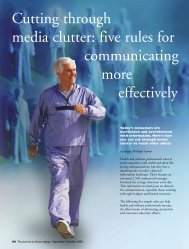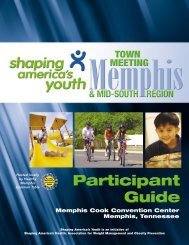Purpose The Active Neighborhood Checklist is an ... - Active for Life
Purpose The Active Neighborhood Checklist is an ... - Active for Life
Purpose The Active Neighborhood Checklist is an ... - Active for Life
You also want an ePaper? Increase the reach of your titles
YUMPU automatically turns print PDFs into web optimized ePapers that Google loves.
A2. Undeveloped l<strong>an</strong>d: Large area of natural space that <strong>is</strong> not maintained<br />
by public or private entities.<br />
A2. Designated green space: Large area of natural space that <strong>is</strong><br />
maintained by public or private entities <strong>an</strong>d open to the public.<br />
A5.Off-road walking/biking trail: Off-road sidewalk or trail (including<br />
sidewalks around parks) that people walk or bike on primarily <strong>for</strong> exerc<strong>is</strong>e<br />
or le<strong>is</strong>ure.<br />
A6. Indoor fitness centers: Examples include yoga, pilates, d<strong>an</strong>ce, <strong>an</strong>d<br />
martial arts studios, public recreation centers, <strong>an</strong>d indoor tenn<strong>is</strong> clubs.<br />
A6. Big box store: Large, rect<strong>an</strong>gular commercial buildings, typically with<br />
st<strong>an</strong>dardized facades, large parking lots, <strong>an</strong>d facing major traffic arterials.<br />
Examples include Walmart, Office Depot, Best Buy, <strong>an</strong>d Home Depot.<br />
A6. Strip mall: Commercial centers with attached units arr<strong>an</strong>ged in a row,<br />
typically denoted by a sign. Th<strong>is</strong> <strong>is</strong> <strong>an</strong> indicator of <strong>an</strong> auto-oriented street<br />
so it should not be selected <strong>for</strong> all connected commercial units.<br />
A. L<strong>an</strong>d use notes: Note major natural l<strong>an</strong>dscape features (e.g., lakes,<br />
rivers), major barriers (e.g., railroad tracks, highway), or other d<strong>is</strong>tinct l<strong>an</strong>d<br />
use character<strong>is</strong>tics or destinations.<br />
B. Tr<strong>an</strong>sit stop notes: Note the condition of a tr<strong>an</strong>sit stop.<br />
C2. Special speed zones: Speed limit signs <strong>for</strong> special situations, such as<br />
school zones, construction zones, or sharp turns in the roadway.<br />
C3. Total # of l<strong>an</strong>es: Number of l<strong>an</strong>es (including unmarked l<strong>an</strong>es) <strong>for</strong><br />
traffic. Excludes the turning l<strong>an</strong>e <strong>an</strong>d parking l<strong>an</strong>es<br />
C5. Medi<strong>an</strong> or pedestri<strong>an</strong> <strong>is</strong>l<strong>an</strong>d: Ra<strong>is</strong>ed <strong>is</strong>l<strong>an</strong>d or refuge <strong>for</strong> pedestri<strong>an</strong>s<br />
between traffic l<strong>an</strong>es. May take up all or part of the segment. Extremely<br />
narrow medi<strong>an</strong>s or medi<strong>an</strong>s with so much l<strong>an</strong>dscaping as to prevent<br />
pedestri<strong>an</strong>s from using them should not be counted.<br />
C6. Turn l<strong>an</strong>e: Only count turn l<strong>an</strong>es that occupy a l<strong>an</strong>e <strong>for</strong> the entire<br />
length of the roadway.<br />
C7. Crosswalk: Denoted by painted white line(s), flashing light(s), <strong>an</strong>d/or<br />
pedestri<strong>an</strong> crossing sign(s)<br />
C9. Traffic calming device: Device intentionally designed to reduce traffic<br />
speed or volume, such as a roundabout, brick road, speed hump, flashing<br />
speed sign, or “watch <strong>for</strong> children” sign. Curb bulb-outs (technically<br />
crossing aids) are areas of the sidewalk/curb that extend into the street,<br />
mostly at intersections, to shorten pedestri<strong>an</strong> crossing d<strong>is</strong>t<strong>an</strong>ces.<br />
C10a. Sidewalk cut-through: Sidewalk or path that connects a cul-de-sac<br />
to a nearby street or greenbelt without permitting passage of automobiles.<br />
C. Street character<strong>is</strong>tic notes: Note street character<strong>is</strong>tics that may<br />
influence a pedestri<strong>an</strong>’s or bicycl<strong>is</strong>t’s feelings of com<strong>for</strong>t <strong>an</strong>d safety from<br />
traffic, such as perceived traffic volume <strong>an</strong>d speed, aggressive drivers,<br />
<strong>an</strong>d condition of crossing aids <strong>an</strong>d medi<strong>an</strong>s.<br />
D1. Commercial buildings adjacent to the sidewalk: Building that c<strong>an</strong> be<br />
entered directly from the sidewalk along the street without crossing a<br />
parking lot. If no sidewalk <strong>is</strong> present, check “no.”<br />
D2a. Bench: Includes public benches along the sidewalk, not in a park.<br />
D2b. Drinking fountain: If the drinking fountain <strong>is</strong> not functional, then do<br />
not count it <strong>an</strong>d note its condition in the notes section.<br />
D3. Public art: Statues, sculptures, fountains, or murals. May include<br />
b<strong>an</strong>ners if they st<strong>an</strong>d out <strong>an</strong>d enh<strong>an</strong>ce the aesthetic quality of the street.<br />
Excludes artwork placed in the windows of commercial buildings or<br />
associated with residential buildings (e.g., yard art, private fountains).<br />
D5. Litter or broken glass: When evaluating the amount of litter <strong>an</strong>d<br />
broken glass, imagine <strong>an</strong> immaculate street <strong>an</strong>d heavily littered street <strong>for</strong><br />
relative compar<strong>is</strong>ons with the street being audited.<br />
D6. Tree shade along the walking area: Evaluate tree shade that would<br />
cover the sidewalk or other walking area at approximately noon. During<br />
months when trees are without leaves, env<strong>is</strong>ion what shade the trees<br />
might provide with leaves. Shade provided by buildings should not be<br />
counted here. As with litter <strong>an</strong>d broken glass, consider the extremes.<br />
D7. Steepest slope along the walking area: Compare the slope along the<br />
segment to a street with a flat slope <strong>an</strong>d a steep slope. A flat/gentle slope<br />
would hardly be noticeable to most individuals. A moderate slope would<br />
not act as a barrier to most individuals but walking on it may increase<br />
some individuals’ heart rates. A steep slope would act as a barrier to<br />
individuals who are not active or with physical limitations.<br />
D. Pedestri<strong>an</strong> environment notes: Note d<strong>is</strong>tinct features that enh<strong>an</strong>ce or<br />
detract from a pedestri<strong>an</strong>’s walking experience.<br />
E2. Any grassy or other buffer between curb <strong>an</strong>d sidewalk along most of<br />
the segment: A buffer includes grass, trees, flowerpots, <strong>an</strong>d/or textured<br />
sidewalk that provides separation between pedestri<strong>an</strong>s <strong>an</strong>d traffic.<br />
E2a. Tree(s) in buffer: Trees provide a buffer from traffic <strong>for</strong> pedestri<strong>an</strong>s,<br />
as well as aesthetic appeal.<br />
E3. Sidewalks continuous within segment: <strong>The</strong>re are no interruptions<br />
(other th<strong>an</strong> driveways) in the sidewalk within a single segment.<br />
E4. Sidewalks continuous between segments at both ends: <strong>The</strong> sidewalk<br />
continues in one or more directions beyond the segment audited. Th<strong>is</strong><br />
must be true <strong>for</strong> both ends of the segment.<br />
E5. Width ≥ 5 ft <strong>for</strong> most of the segment: Width c<strong>an</strong> be determined by<br />
estimating or by measuring each auditor’s foot prior to auditing to<br />
determine how m<strong>an</strong>y “auditor’s feet” would equal 5 feet. In rare cases<br />
when parking lots <strong>an</strong>d sidewalks are juxtaposed, do not count the parking<br />
lot when measuring the width of the sidewalk.<br />
E6. Width < 3 ft <strong>for</strong> <strong>an</strong>y part of the sidewalk: By estimating or using<br />
auditor’s measured foot (see E5), determine if the walking area <strong>is</strong> less<br />
th<strong>an</strong> 3 feet <strong>for</strong> <strong>an</strong>y part of the sidewalk. <strong>The</strong> width may be





